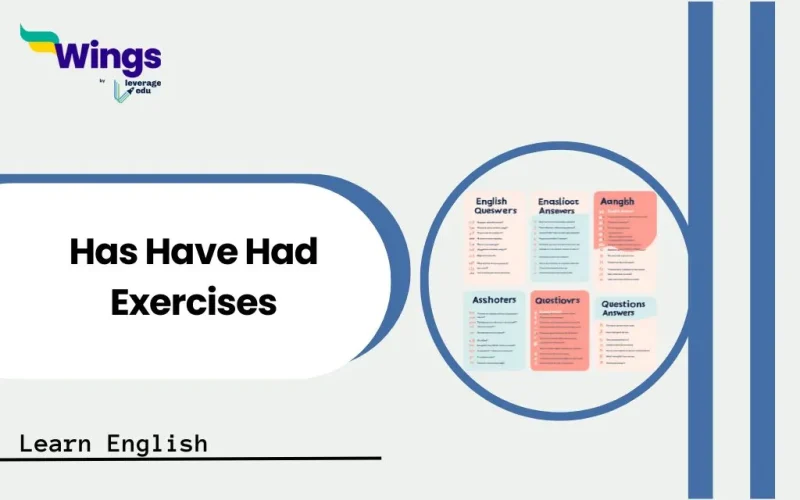Mastering the use of “has,” “have,” and “had” is a fundamental aspect of English grammar that can significantly enhance your communication skills. These auxiliary verbs are not only essential for expressing possession but also play a crucial role in forming various tenses, particularly the present and past perfect tenses. However, many learners find themselves confused about when to use each form, leading to common grammatical mistakes. In this blog, we will explore a series of engaging Has Have Had exercises designed to clarify the distinctions between “has,” “have,” and “had.”
This Blog Includes:
Overview of “Has,” “Have,” and “Had”
Understanding the three forms ‘has’, ‘have’ and ‘had’ is fundamental to mastering English grammar. These auxiliary verbs play a crucial role in expressing possession, actions, and states of being across different tenses. While they may seem straightforward, their correct usage depends on the subject of the sentence and the tense being employed.
Let’s examine all three verb forms to get a basic idea of how they are used in sentences.
- Has: This form is used exclusively with third-person singular subjects (he, she, it). It indicates possession or a current state of being.
Example: “She has a new book” conveys that the subject currently possesses the book.
- Have: This is the base form of the verb and is used with plural subjects (they, we) as well as first-person (I) and second-person (you) subjects.
Example: “They have a lot of work to do,” indicating that the subjects possess work in the present.
- Had: This is the past tense form used for all subjects. It signifies possession or actions that occurred in the past.
Example: “He had a car when he lived in New York” indicates that at some point in the past, he possessed a car.
Also Read: Simple Present Tense Exercises
When to Use Each Form (Useful for Solving Has Have Had Exercises)
Understanding when to use which verb in your writing is very important. Below we have compiled some of the points when you must use these auxiliary verbs in a sentence.
- Use “has” for:
- Singular subjects (he, she, it).
- Present perfect tense when referring to actions completed in the past but relevant to the present.
- Use “have” for:
- Plural subjects (they, we).
- First-person singular (I) and second-person singular/plural (you).
- Use “had” for:
- All subjects are in the past tense.
- Past perfect constructions indicate an action that was completed before another past action.
Also Read: Tenses Cheat Sheet
Key Differences Between “Has,” “Have,” and “Had”
Understanding the distinctions between “has,” “have,” and “had” is crucial for mastering English grammar. These verbs serve as auxiliary verbs and are also used to indicate possession. Below, we outline the key differences in terms of usage, subject agreement, and tense. This will help you solve questions under Has Have Had exercise in the subsequent sections of the blog.
| Verb | Subject Verb Agreement | Tense | Examples |
| Has | Third-person singular | Present | She has a new job. |
| Have | First-person, second-person, plural | Present | I have a car. / They have arrived. |
| Had | All subjects | Past | He had a bike when he was younger. |
Also Read: Rules in Grammar
Has Have Had Exercises with Answers
Here are five exercises focusing on the correct use of “has,” “have,” and “had,” along with their answers. These Has Have Had exercises will help reinforce your understanding of how to use these verbs appropriately in different contexts.
Exercise 1: Fill in the Blanks
Instructions: Complete the following sentences with “has,” “have,” or “had.”
- She ___ a beautiful singing voice.
- They ___ already completed their assignments.
- I ___ a great time at the concert last night.
- He ___ never been to Europe before.
- We ___ a meeting scheduled for tomorrow.
Answers:
- Has
- Have
- Had
- Has
- Have
Exercise 2: Choose the Correct Verb
Instructions: Select the correct form of the verb (“has,” “have,” or “had”) to complete each sentence.
- The teacher ___ given us a lot of homework this week.
- My friends ___ been supportive during tough times.
- She ___ a pet cat when she was younger.
- You ___ done an excellent job on your presentation.
- He ___ a headache yesterday.
Answers:
- Has
- Have
- Had
- Have
- Had
Exercise 3: Rewrite the Sentences
Instructions: Rewrite the following sentences, changing them to use “has,” “have,” or “had” as appropriate.
- (He) own a car now.
- (They) finish their project last week.
- (I) never see such a beautiful sunset before.
- (She) always love chocolate ice cream.
- (We) go to that restaurant many times.
Answers:
- He has a car now.
- They had finished their project last week.
- I have never seen such a beautiful sunset before.
- She has always loved chocolate ice cream.
- We have gone to that restaurant many times.
Exercise 4: Question Formation
Instructions: Form questions using “has,” “have,” or “had” based on the prompts provided.
- (She / finish her homework)
- (You / ever travel abroad?)
- (They / see the new movie?)
- (He / eat breakfast this morning?)
- (We / visit that museum last summer?)
Answers:
- Has she finished her homework?
- Have you ever travelled abroad?
- Have they seen the new movie?
- Did he eat breakfast this morning? (Note: Use “did” for past tense)
- Did we visit that museum last summer? (Note: Use “did” for past tense)
Exercise 5: Correct the Mistakes
Instructions: Identify and correct the mistakes in the following sentences related to the use of “has,” “have,” and “had.”
- She have a dog named Max.
- They has completed their tasks on time.
- I had seen that movie last week.
- He have a lot of friends in college.
- We has enjoyed our vacation last year.
Answers:
- She has a dog named Max.
- They have completed their tasks on time.
- I saw that movie last week. (Corrected for past tense)
- He has a lot of friends in college.
- We had enjoyed our vacation last year.
Has Have Had Exercises with Answers (PDF)
Here are some more Has Have Had exercises along with their answers, which can be useful for practice. You can easily save and download this PDF for future reference.
Explore more such blogs on Learn English!
FAQs on Has Have Had Exercises
Use “has” with singular subjects.
Examples:
She has a dog.
The cat has green eyes.
He has finished his homework.
1. Use “have” with plural subjects.
Examples:
We have a meeting today.
The students have completed the assignment.
They have been to Paris.
2. Use “have” with the pronouns “I,” “you,” “we,” and “they.”
Examples:
I have a headache.
You have a nice car.
We have a lot of work to do.
“Have” and “have got” are generally interchangeable, but “have got” is more common in British English.
Example: I have a car. or I have got a car.
1. Practice! The best way to learn is to use these verbs in your own sentences and pay attention to how they sound.
2. Use a mnemonic device: For example, “He Has, We Have.”
We hope this blog on Has Have Had Exercises was informative and helped you improve your English language skills. You can also follow the Learn English page of Leverage Edu for more exciting and informative blogs related to English grammar and the English language.
 One app for all your study abroad needs
One app for all your study abroad needs















 60,000+ students trusted us with their dreams. Take the first step today!
60,000+ students trusted us with their dreams. Take the first step today!

